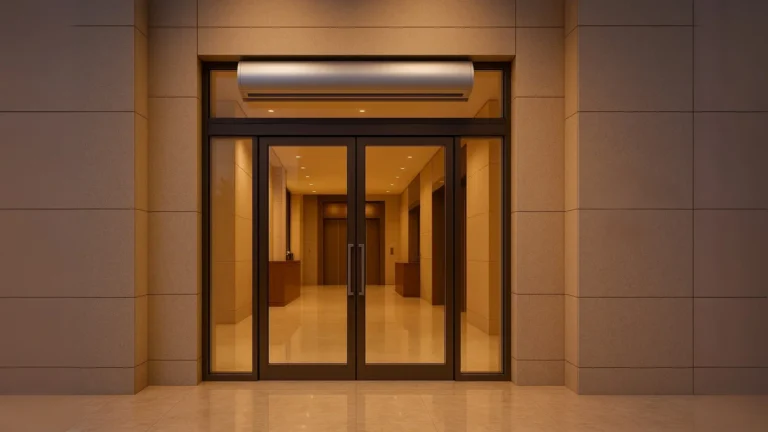
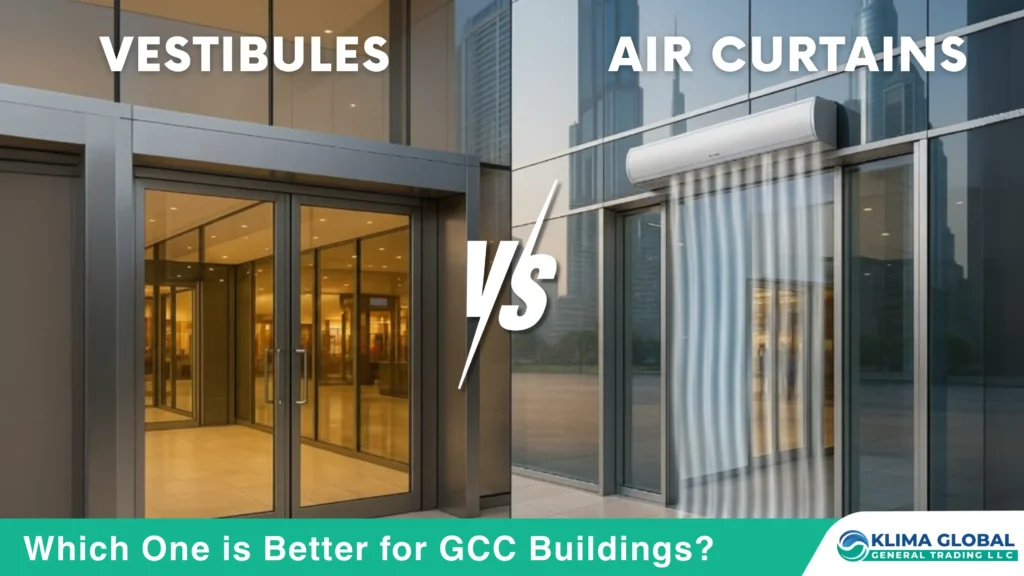
Air Curtains vs Vestibules: Choosing the Right Solution for GCC Buildings
Building entrances in the GCC face a unique challenge: extreme outdoor heat, dusty conditions, and high energy bills caused by HVAC overuse. Two popular solutions are often considered to tackle this— air curtains vs vestibules. Both approaches aim to minimize air infiltration, protect comfort, and reduce energy losses. But which is better suited for UAE, Saudi Arabia, and the wider GCC? This article provides a comprehensive comparison of their efficiency, ROI, technical performance, and long-term practicality. We will also highlight which solution aligns best with regional energy efficiency goals and sustainability programs.
What is a Vestibule?
A vestibule is an enclosed entryway space with two sets of doors—one leading outside and one to the inside. Its main purpose is to reduce the direct flow of hot outdoor air into the cooled indoor space by creating a buffer zone.
Advantages: Passive air barrier, traditional design, effective for low-to-medium traffic buildings.
Limitations: Requires additional space, construction costs, and maintenance of extra doors. Not ideal for retrofits or buildings with limited entrance space.
Vestibules have historically been used in malls, airports, hotels, and offices to control infiltration. However, they can be expensive to construct, may reduce leasable space, and often lack flexibility when building designs change or expand. Their effectiveness is also reduced in very high-traffic environments, which are common in GCC commercial facilities.
What is an Air Curtain?
An air curtain is a modern solution installed above or beside a doorway that blows a high-velocity stream of air across the opening, forming an invisible barrier. This barrier prevents the mixing of indoor and outdoor air without limiting entry access.
Cross-Flow Models: Designed for doors up to 3.5m in height, common in retail shops, cafes, and restaurants.
Centrifugal Models: Built for higher entrances up to 8m, suitable for warehouses, malls, and industrial facilities.
Cold Room & Heated Options: Specialized designs available for refrigerated facilities and heated indoor environments.
Air curtains are increasingly popular in GCC markets due to their slim designs, ease of retrofitting, quick installation, and proven impact on reducing HVAC energy waste. They also align with regional green building codes and can easily integrate into new or existing facilities.
Energy Efficiency Comparison: Air Curtains vs Vestibules
Vestibules: Act as passive enclosures that slow down infiltration. They are somewhat effective, but their ability to stop infiltration is limited when doors are continuously opened, especially in busy commercial settings.
Air Curtains: Provide an active and continuous air barrier that can prevent up to 90% of conditioned air loss. Even during peak traffic hours, air curtains maintain strong performance.
According to ASHRAE and DOE studies, air curtains often outperform vestibules in real-world infiltration scenarios. In GCC conditions—where air conditioning represents 60–70% of energy use—air curtains prove to be a superior solution for energy saving entrance solutions UAE and the wider region.
ROI: Air Curtains vs Vestibules
Vestibules: Require significant capital investment in construction, additional HVAC integration, and door maintenance. ROI is typically slow, often taking 3–5 years.
Air Curtains: Involve lower upfront equipment costs, minimal space requirements, and quick installation. In GCC, ROI is typically achieved in 12–24 months, making them attractive for both new and existing buildings.
Lifecycle Cost Comparison
| Factor | Vestibule | Air Curtain |
|---|---|---|
| Upfront Cost | High (construction, design) | Moderate (equipment + install) |
| Space Requirement | Large | Minimal |
| ROI | 3–5 years | 1–2 years |
| Flexibility | Permanent structure | Can be retrofitted easily |
| Maintenance | Doors, HVAC alignment | Low, simple servicing |
For facility managers focused on return on investment, air curtains present a compelling case. They deliver quick savings, reduce HVAC wear, and require less ongoing maintenance.
Space & Design Considerations
One of the biggest drawbacks of vestibules is space. They consume valuable square footage in high-value areas such as Dubai malls or Riyadh hotels. This reduces usable or leasable space that could otherwise generate revenue.
Air curtains, however, are compact, unobtrusive, and adaptable to a wide range of entrances. They can be surface-mounted, recessed, or built into architectural designs without changing the building layout. This makes them the preferred vestibule alternative UAE developers and architects are increasingly specifying.
Technical Selection Guide
Choosing the right air curtain requires considering several key factors:
Door Height & Width: Determines whether cross-flow or centrifugal models are appropriate.
Traffic Levels: High-traffic areas need stronger and continuous airflow barriers.
Application Type: Retail, industrial, cold storage, or healthcare each demand different features.
Noise Levels: Hospitality and healthcare environments require quieter operation.
Energy Efficiency Ratings: Select models tested for performance under GCC conditions.
👉 For an in-depth breakdown, see our [Air Curtain Technical Selection Guide].
Sustainability & Green Building Goals
Vestibules: Increase construction footprint, materials use, and long-term maintenance burden.
Air Curtains: Support sustainability by lowering HVAC loads, reducing CO₂ emissions, and aligning with regional goals. They contribute to LEED credits, Estidama compliance, and DEWA’s energy efficiency targets.
In line with Saudi Vision 2030 and UAE Net Zero 2050, businesses across the GCC are expected to adopt innovative solutions that reduce energy use. Air curtains provide a proven way to achieve both financial and environmental targets.
Case for GCC Applications
Air curtains are well-suited for a wide range of sectors:
Shopping Malls: Prevent cooled air loss at revolving entrances and maintain customer comfort.
Hotels & Hospitality: Provide seamless, draft-free lobbies without compromising design aesthetics.
Industrial Warehouses: Manage large, frequently used loading bays where vestibules are impractical.
Healthcare Facilities: Improve infection control by reducing airborne contaminants and stabilizing temperature.
Cold Storage: Essential for maintaining consistent temperatures and protecting perishable goods.
Airports & Transport Hubs: Support smooth passenger flow while keeping HVAC costs in check.
In GCC climates where entrances are busy and energy efficiency is a national priority, air curtains consistently deliver stronger outcomes than vestibules.
Conclusion
Both air curtains and vestibules have roles in managing energy loss at building entrances. However, when evaluated on ROI, adaptability, space efficiency, and alignment with sustainability goals, the comparison of air curtains vs vestibules heavily favors air curtains in the GCC context. They are less expensive to implement, easier to integrate into modern architecture, and deliver faster and more measurable results.
For building owners, facility managers, and developers seeking energy saving entrance solutions UAE and GCC, air curtains provide a forward-looking, cost-effective alternative.
Looking for tailored recommendations? Contact Klima Global today to learn how our air curtain solutions can deliver rapid ROI and long-term HVAC efficiency in UAE, Saudi Arabia, Oman, Bahrain, Qatar, Kuwait and beyond.
FAQs: Air Curtains vs Vestibules
For GCC projects, when is an air curtain better than a vestibule—and vice versa?
Choose an air curtain when you have limited footprint, need a retrofit-friendly solution, want lower CapEx and quick installation, or must keep an open, welcoming storefront (malls, hotels, QSR). Properly sized units maintain the floor velocity barrier while minimizing noise.
Choose a vestibule in new builds where architecture already accommodates an airlock (security/concierge desks, queue management, or severe wind tunnels). Vestibules can reduce door-open exposure time, but they consume space and add architectural cost.
Hybrid: vestibule + air curtain on the outer door often gives the best envelope performance in wind-exposed sites.
Do air curtains really match vestibules for comfort and energy in the GCC’s T3 climate?
When sized and commissioned correctly (unit width = door width, 0–10° nozzle angle, target ~2.0–2.5 m/s in lobbies; 2.5–3.0 m/s where insects/wind are issues), air curtains significantly cut hot air infiltration, improving comfort and reducing cooling load—without building a physical lobby. Add door-open interlocks and BMS schedules to limit run time and average noise.
Can we combine a vestibule with an air curtain, and where should it be located?
Yes. The most effective hybrid is an air curtain on the exterior door of the vestibule. It blocks dust/heat/insects before they enter the buffer zone, while the vestibule reduces the duration of exposure and pressure swings. Interlock the air curtain to the door sensor, add a short pre-start and run-on delay, and verify sill velocity with an anemometer during commissioning.
Which option has the better total cost of ownership (TCO) for hotels, offices, and retail?
Air curtains: Lower CapEx, quick install, minimal architectural works. TCO depends on controls (door interlocks/BMS), routine cleaning, and annual checks. Properly maintained, they deliver strong kWh savings by curbing infiltration.
Vestibules: Higher CapEx (civil/fit-out), longer timelines, ongoing HVAC/lighting/cleaning costs for the added space. May be preferred where security/queuing functions are required.
For many GCC retrofits, air curtains provide faster ROI; for new prestige builds with planned lobbies, vestibules can complement or host an air curtain on the exterior leaf.
What about acoustics, aesthetics, codes, and fire/life-safety?
Acoustics: For premium spaces, target ≤45–50 dB(A) at ~2 m during “door-open” operation; select low-noise cross-flow models for ≈2.3–3.0 m mounts, or centrifugal for taller/windy portals.
Aesthetics: Sleek, designer casings (e.g., Model O/G) blend with five-star interiors; vestibules add visible depth and can host concierge/security.
Codes & AHJ: Vestibule requirements are jurisdiction- and project-specific. In the GCC, coordinate with the Authority Having Jurisdiction (AHJ) and your consultant. Air curtains are typically interlocked to stop on fire alarm/evacuation—document points in submittals and verify at commissioning.
Get Customized Air Curtains for your Project!
Share this post
Related Posts

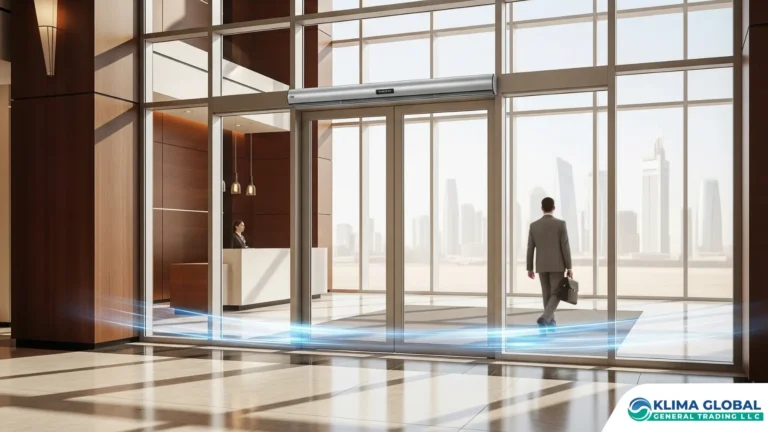
Best Air Curtain Supplier in Saudi Arabia | Buyer’s Guide
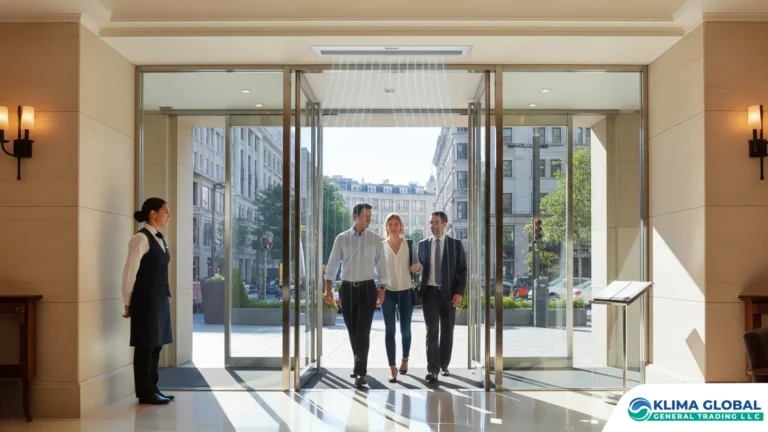
Low Noise Air Curtain | Silent Air Curtains for Hotels & Offices
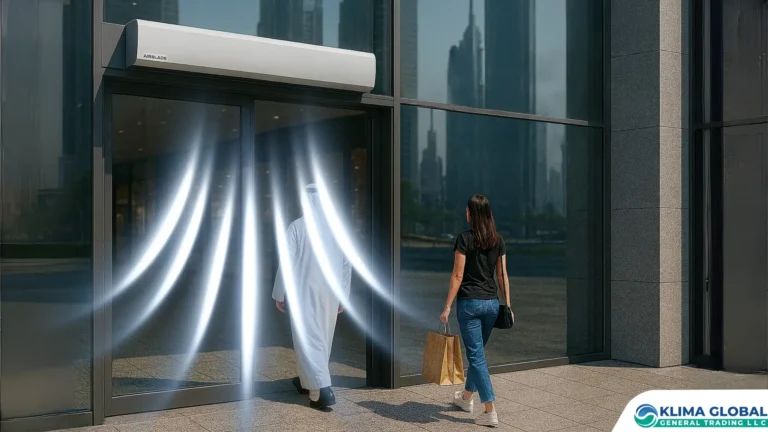
The Ultimate Guide to Air Curtains in the Middle East

Air Curtain Maintenance Guide –Checklist, Service & Lifespan
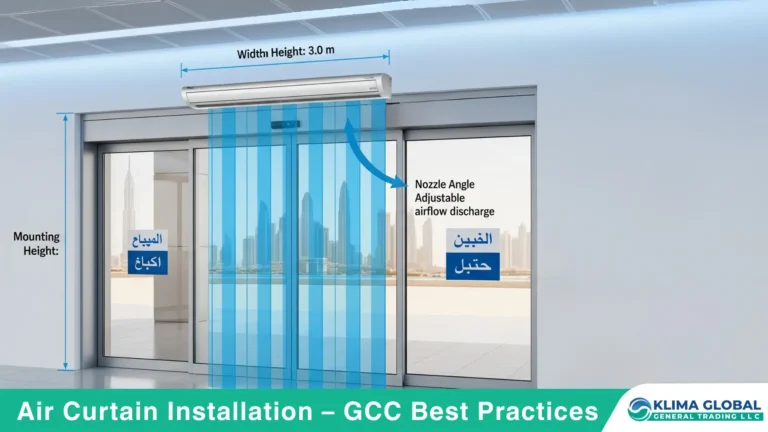
Air Curtain Installation Guide – Mounting, Sensors & BMS
Latest Posts

Best Air Curtain Supplier UAE | 2025 Buyer’s Guide

Best Air Curtain Supplier in Saudi Arabia | Buyer’s Guide

Low Noise Air Curtain | Silent Air Curtains for Hotels & Offices

The Ultimate Guide to Air Curtains in the Middle East

Air Curtain Maintenance Guide –Checklist, Service & Lifespan

Air Curtain Installation Guide – Mounting, Sensors & BMS
